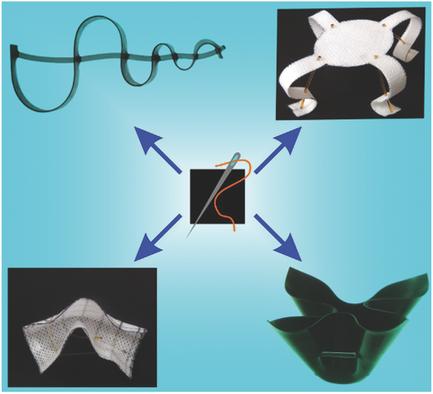当前位置:
X-MOL 学术
›
Macromol. Rapid Commun.
›
论文详情
Our official English website, www.x-mol.net, welcomes your
feedback! (Note: you will need to create a separate account there.)
4D Origami by Smart Embroidery
Macromolecular Rapid Communications ( IF 4.2 ) Pub Date : 2017-07-31 , DOI: 10.1002/marc.201700213 Georgi Stoychev 1, 2 , Mir Jalil Razavi 2 , Xianqiao Wang 2 , Leonid Ionov 1, 2
Macromolecular Rapid Communications ( IF 4.2 ) Pub Date : 2017-07-31 , DOI: 10.1002/marc.201700213 Georgi Stoychev 1, 2 , Mir Jalil Razavi 2 , Xianqiao Wang 2 , Leonid Ionov 1, 2
Affiliation

|
There exist many methods for processing of materials: extrusion, injection molding, fibers spinning, 3D printing, to name a few. In most cases, materials with a static, fixed shape are produced. However, numerous advanced applications require customized elements with reconfigurable shape. The few available techniques capable of overcoming this problem are expensive and/or time‐consuming. Here, the use of one of the most ancient technologies for structuring, embroidering, is proposed to generate sophisticated patterns of active materials, and, in this way, to achieve complex actuation. By combining experiments and computational modeling, the fundamental rules that can predict the folding behavior of sheets with a variety of stitch‐patterns are elucidated. It is demonstrated that theoretical mechanics analysis is only suitable to predict the behavior of the simplest experimental setups, whereas computer modeling gives better predictions for more complex cases. Finally, the applicability of the rules by designing basic origami structures and wrinkling substrates with controlled thermal insulation properties is shown.
中文翻译:

智能刺绣的4D折纸
有许多材料处理方法:挤出,注塑,纤维纺丝,3D打印等。在大多数情况下,会生产出具有静态固定形状的材料。但是,许多高级应用程序需要具有可重新配置形状的自定义元素。能够克服此问题的几种可用技术是昂贵和/或费时的。在此,提议使用最古老的技术之一进行结构化,刺绣,以产生活性材料的复杂图案,并以此方式实现复杂的驱动。通过结合实验和计算模型,阐明了可以预测具有多种针迹样式的纸张折叠行为的基本规则。结果表明,理论力学分析仅适合于预测最简单的实验装置的行为,而计算机建模可以为更复杂的情况提供更好的预测。最后,通过设计基本折纸结构和起皱具有受控隔热性能的基材,显示了规则的适用性。
更新日期:2017-07-31
中文翻译:

智能刺绣的4D折纸
有许多材料处理方法:挤出,注塑,纤维纺丝,3D打印等。在大多数情况下,会生产出具有静态固定形状的材料。但是,许多高级应用程序需要具有可重新配置形状的自定义元素。能够克服此问题的几种可用技术是昂贵和/或费时的。在此,提议使用最古老的技术之一进行结构化,刺绣,以产生活性材料的复杂图案,并以此方式实现复杂的驱动。通过结合实验和计算模型,阐明了可以预测具有多种针迹样式的纸张折叠行为的基本规则。结果表明,理论力学分析仅适合于预测最简单的实验装置的行为,而计算机建模可以为更复杂的情况提供更好的预测。最后,通过设计基本折纸结构和起皱具有受控隔热性能的基材,显示了规则的适用性。











































 京公网安备 11010802027423号
京公网安备 11010802027423号